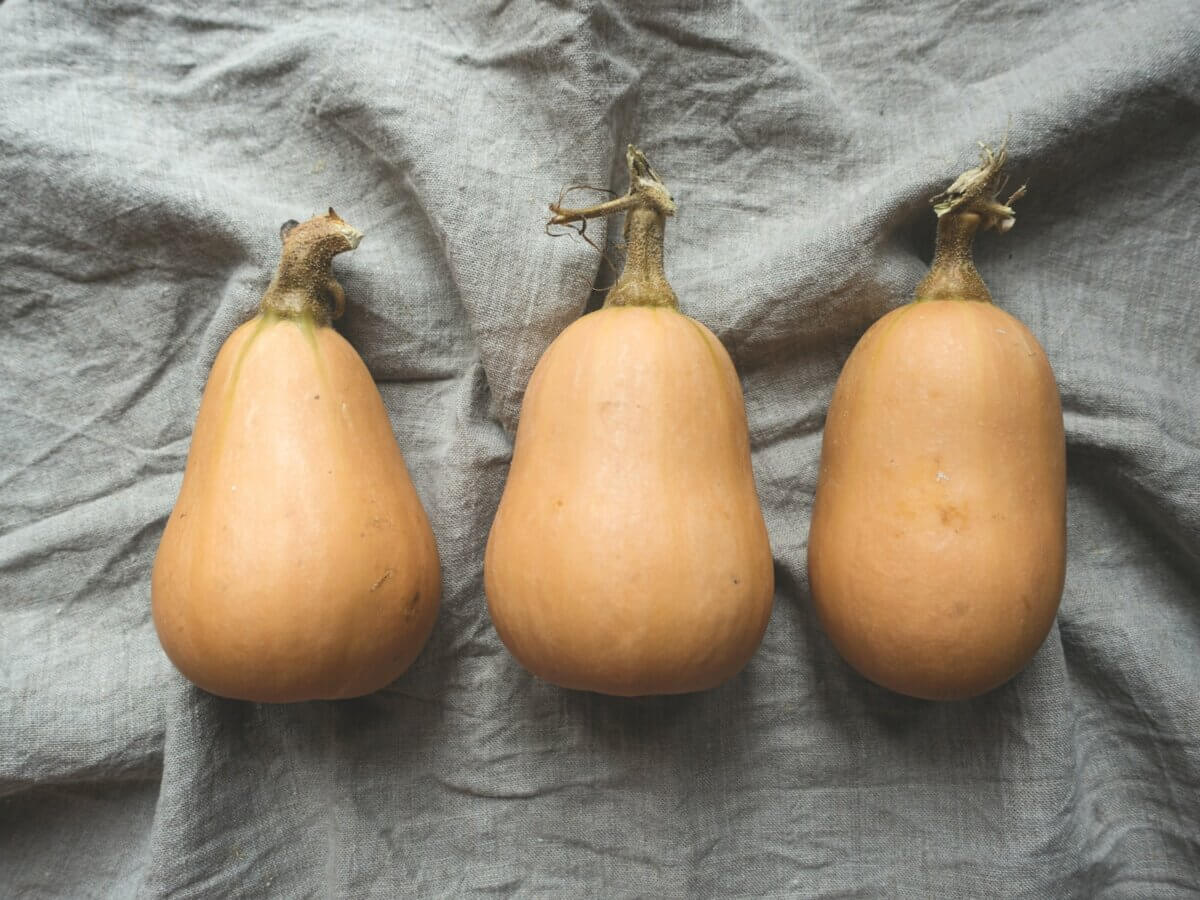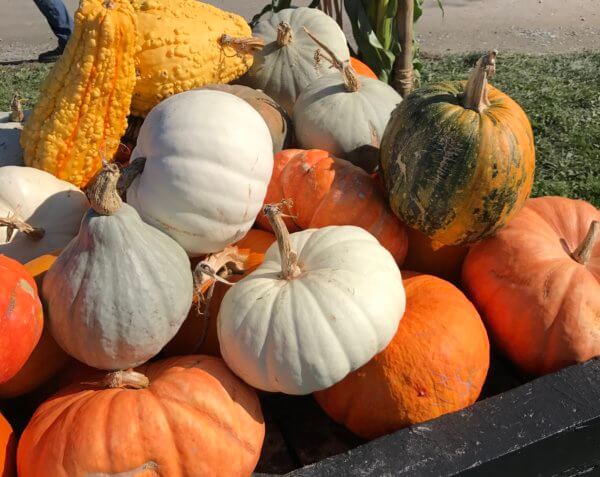Why do homesteaders grow pumpkins or winter squash? While the process may be challenging, the reward could be enormous. There are dozens of varieties of pumpkins and winter squash, weighing from 2 lbs. to 500! What’s in your garden?
Read on to discover harvest, curing, and storage tips for the seasonal vegetable that is the best representative of the idyllic rural homestead farm lifestyle.
Popular Varieties Of Squash And Pumpkins
Acorn Squash
Similar in shape to its namesake, the acorn presents a fruit that is bright orange-yellow, firm and flavorful, with a subtly sweet, nutty taste.
Pink Peanut Pumpkins
Pink peanut pumpkins are a colorful addition to holiday décor and taste great in pies, puddings, soups, and stews. The rind is dense, thick and bumpy: the flavor sweet and earthy.
Baby Bear And Sugar Baby
These varieties are orange-fleshed pumpkins that typically weigh less than 10 pounds. These two flavorful and finely textured pumpkins are a homestead favorite for holiday pies.
Spaghetti Squash
Spaghetti squash presents a cylindrical shape, firm texture, and a thick, white-to-yellow colored rind. When cooked, the squash flesh is moist and meaty, with strands that resemble spaghetti.
Although it does not taste like pasta, the meat of the squash has a chewy texture and mild flavor that makes it an gluten-free substitute for spaghetti noodles in a diverse array of dishes.
Red Kuri
Red kuri squash exhibits a rind color and texture like that of the acorn squash. The flesh is firm, finely textured, sweet, and packed full of nutty goodness. This variety works well in all your favorite squash recipes.
Or, consider sprinkling red kuri with a bit of olive oil and grilling it as a delicious side dish to steaks or chops.
Butternut Squash
Butternut squash, also known as butternut pumpkin, has a pronounced bell shape and bright yellow rind. The flesh of the fruit is sweet and firm.

Pink Lady Squash
Similar in texture and taste to red kuri or acorn squash, pink lady squash has a dark green, dense, rind and meaty, bold orange flesh. It’s great in soups, stews, and sauces.
Jarrahdale
Jarrahdale, known as the little blue pumpkin, exhibits bright orange, finely textured flesh and a sweet, honeyed flavor.
Excellent in pies, soups, curries, and stews, the small round pumpkin stores well through the winter.
Green-Striped Cushaw
These pumpkins are an all-time favorite for pies, puddings, soups, curries, and stews. Presenting a bold, nutty flavor and creamy texture, this tasty pumpkin works well in any recipe in which pumpkin is a primary ingredient.
Delicata
Delicata is a small squash featuring a bright yellow skin with bold green markings that is similar in taste and texture to butternut squash. The rind of this delicate squash is thinner than butternut, however, the two are interchangeable in your favorite recipe.
Because they have a delicate, thin rind, delicata squash do not keep as long in storage as squash with a tougher rind. They will, however, store well in the refrigerator crisper for several weeks.
Lakota
Lakota is a tiny, bright orange, pear-shaped pumpkin with a deliciously sweet flavor and smooth texture. Try lakota in tarts, pastries, or curries for a taste treat to remember.
Turban Squash
The turban squash is aptly named, resembling a brightly colored cloth turban. The rind is bumpy, rough, and dull-looking with a broad range of color combinations from mottled orange and yellow to bright green and white.
Often used as a seasonal decoration, turban squash is similar in taste and texture to acorn squash. Try using a hollowed out turban squash as an attractive serving tureen for stews, soups, gravy, or holiday sauces.
Carnival Squash
Carnival squash, similar in shape, size, and flavor to a dumpling or acorn squash, presents a firm, meaty texture and bright yellow, succulent, and sweet flesh.
Cow Pumpkins
Cow pumpkins, known for their creamy texture and subtle nut-like flavor are excellent additions to pies, puddings, soups, and stews. Cow pumpkins have a smooth, tough pale orange rind, store well, and taste great.
Kabocha Squash
Kabocha squash, commonly known as Japanese pumpkin or Kent pumpkin, presents a delicate sweetness and firm texture similar to butternut squash.
The kabocha squash is round with a base that points out. Both the red and green varieties of kabocha squash are round with white stripes. In recipes, the two are interchangeable, however, the red variety is noticeably sweeter.
Tips For Harvesting
Warm-season crops cultivated throughout the United States, winter squash and pumpkins are slow to grow, requiring 75-120 days to reach maturity.
They are ready for harvest when they have developed a hard, protective skin and the vines begin to toughen, shrivel, and dry.
To test for maturity, run a thumbnail across the fruit skin. When squash and pumpkins are fully mature, your nail should not leave a visible mark. When ripe and ready for harvest, pumpkins and winter squash should feel firm and heavy for their size.
Related Post: Companion Planting For Summer Squash
Pumpkin, the most popular member of the squash family, and all varieties of winter squash should be harvested in late September or early October, before the first frost. Fruits exposed to freezing temperatures will start to rot quickly.

If frost is in the forecast before the fruit ripens, cover each fruit with a protective blanket or cardboard box to prevent frost damage.
At harvest time, cut, do not pull, ripened fruit from the vine. When harvesting pumpkins and winter squash, cut the stem 3-to-4 inches from the fruit. Squash and pumpkins without stems tend to rot when stored.
Hubbard squash is the exception. Hubbard squash stores best with stems removed. Remember to handle pumpkins and winter squash carefully to prevent bruising. A broken or damaged stem can cause the fruit to rot, so never use the stem to lift or move squash or pumpkins.
At harvest time, be sure to don protective leather gloves as both pumpkins and winter squash have painful prickles on the stem.
Curing Winter Squash For Storage
To cure pumpkins and winter squash for storage, wipe off each fruit with a damp cloth rinsed in a solution of 1 part household bleach to 10 parts water. Pat dry and place in a sunny spot outdoors for 7-10 days.
Tips For Storing Winter Squash
Properly cultivated, handled and cured, most varieties of pumpkin and winter squash will last through January.
When selecting pumpkins and winter squash for storage, choose unblemished fruit free of cracks or bruising. Any spot that is bruised or damaged will only get worse and spoilage can affect the quality and flavor of other squash in storage.
Brown Paper Bags Are Your Friend!
Wrap squash in brown paper bags or squares of cloth. Squash stores best when not placed directly on hard surfaces or directly touching each other. Although it makes it a bit more difficult to check them for spoilage, a protective wrapping will extend the storage life of winter squash, keeping them firm and flavorful.
Winter squash and pumpkins tend to deteriorate rapidly when storage temperature drops below 50 degrees Fahrenheit. To determine the best storage location in your homestead for produce, place inexpensive thermometers in dark and dry spots and monitor fluctuations in the temperature.
Select a dark and dry storage area such as a root cellar, pantry, closet, or cupboard where temperatures between 50-60 degrees Fahrenheit and a relative humidity of 75 percent can be consistently maintained. Fluctuating temps lead to rotting.
Location, Location, Location!
Pumpkins and winter squash should be stored on shelves that allow for air circulation, rather than stored on cold concrete floors. The more durable types of winter squash, such as Hubbard, may be stacked on shelving if adequate air circulation is provided.
Moisture encourages the growth of bacteria and fungi. Circulating air helps prevent moisture from accumulating on the exterior of the squash. Avoid storing squash or pumpkins near pears, apples, or other ripening stone fruit. Ethylene gas, produced by ripening fruit, causes squash to discolor and reduces storage life.
America Loves Pumpkin
Harvested in autumn, boldly colored, firm and flavorful, pumpkins and winter squash are staple ingredients in cold-weather meals. High in fiber, low in calories, and packed full of nutrition, pumpkin and squash are rich sources of beta-carotene, carbohydrates, and potassium. Did you know that pumpkin pie was first served at the Pilgrim’s second Thanksgiving in 1623?
The United States Department of Agriculture, Economic Research Service, notes that in 2014 more than 90,000 acres of farmland in Michigan, Illinois, New York, Ohio, California, and Pennsylvania produced more than 1.5 billion pounds of pumpkin. Now that’s a lot of pumpkins!
Related Post: 20 Pumpkins You Should Have Planted This Year
Pumpkins keep well for several months in cool, dry storage. In 2016, farmers and commercial growers in the United States produced more pumpkins than any other popular vegetable including cucumbers, kale, spinach, or squash.
Denser, with a sweeter flavor and firmer texture than summer squash, winter squash also keeps well throughout the long winter months for which it is named.
References
- Pumpkins, University of Illinois Extension – Pumpkins
- Storing Pumpkin And Winter Squash At Home, Oregon State Extension
- Pumpkin — Pie Fun Facts, American Pie Council
- Growing Pumpkins And Winter Squash in Minnesota Home Gardens, Minnesota State Extension









































Leave a Reply